Rikon 10-324 Bandsaw Review
I was in dire need of a bandsaw to finish a couple of Christmas presents (The two-color reindeer ornament and some cutting boards). A bandsaw had been on my list for quite awhile. Ordinarily, it’d be preferable to wait for a nice used machine to show up on Craigslist. This is how I got a great deal on my Delta 36-650 table saw. Unfortunately, as several months passed, everything available was either junk, overpriced, or both.
Uncharacteristically for me, I broke down and bought a brand new tool, a Rikon 10-324 Bandsaw. After looking at several alternatives, this seemed like the best deal for $700 on sale at my local Woodcraft. I’ll go over the options I considered below.
Also, regarding size – my shop really needed a basic 14″ bandsaw to start with. If I get into more resawing in the future, I may try to build a 20″ bandsaw using the plans available from Matthias Wandel at woodgears.ca. However, I wanted to start with a smaller machine that could take 1/8″ blades and do more fine scroll work. This eliminated a lot of the really large bandsaws in my price range.
Rejected Option – Cheap Delta or Delta Clone
A junk bandsaw is junk no matter how cheap it is. After using a crappy 3-wheel bandsaw for awhile, it simply wasn’t worth it to get another piece of junk. This knocked a lot of the cheaper Delta clone models, such as Porter-Cable, Ridgid, and Harbor Freight, firmly out of the running. Some people have gone to great lengths to make these $300-$400 bandsaws perform like the Rikon I ended up buying, but it seemed like a lot of work to save very little money, after accounting for the price of all the upgrades.
These cheap bandsaws are based on an old Delta bandsaw design that is decades old. Another popular option is to simply buy an old Delta 14″ bandsaw, one of the originators of this design. On the plus side, the old saws tend to be better-built than the newer models that mimick them. Unfortunately, there were two problems with going this route. One was that used authentic Deltas have gotten rather expensive, at least in my area. Ones that needed a lot of work were still around $200, and anything still usable seemed to be upwards of $350-$400. I saw several listings for $500-$600!
Even if I had bought one for $350, they came with fairly weak motors back in the day and are missing a lot of modern features, such as quality blade guides. There are plenty of ways to retrofit these upgrades to such a saw, and it’s a very common approach. Unfortunately, this would end up again costing as much as a quality new machine. I would also have to put more time into the saw and run the inherent risk that comes with used tools.
None of these options seemed worth it, so I looked at Grizzly and Rikon.
Rejected Option 2 – Grizzly Bandsaw
Grizzly has gotten quite a good reputation these days. Their G0555 14″ Bandsaws is one of their staples, and is very well regarded. Although the machine is ordinarily around $665 shipped, Grizzly frequently offers free shipping. The saw has a resaw limit of 6″, albeit they do offer their 6″ riser block kit
.
The other option would be to spend a bit more money and get a Grizzly G0513. This is the 17″ version, with a 2HP motor and 12-1/8″ resaw capacity. This is a bit expensive at full price, but they have historically gone on sale around $800 with free shipping.
At the end of the day, I could understand buying either of these bandsaws. They offer a lot for their price points and have won over many customers as a result. However, I found the Rikon to be at least as good a deal, with the added convenience that I could go pick it up at the local Woodcraft.
Rikon 10-324 vs Grizzly Bandsaws
As I said, I bought my Rikon 10-324 on sale at my local Woodcraft for $700. This slotted it in price right between the two Grizzly machines when on sale. I think it offered the best of both worlds in terms of features.
The Rikon has more power and resaw capacity than the G0555. It has a 1.5hp (14amp) motor vs only 1hp (11amp) on the Grizzly. Additionally, it can resaw up to 13″ tall out of the box, where the Grizzly is limited to 6″ standard, and 12″ with the riser block. I haven’t done any resaw testing yet, but I also expect the Rikon to outperform a G0555 with a riser block. Aside from the power advantage, the Rikon frame appears to be made of thicker steel, and I would expect it to be stiffer as a result. Unfortunately, I don’t have a G0555 in my shop to do a comparison with a dial indicator. Either way, the Rikon is only $150 more than the standard G0555 when they’re both on sale. However, as soon as you add a riser block, they’re basically the same price except the Rikon is the better saw.
The Rikon has less power than the G0513, but this means I can run it on the 110 power in my shop without tripping the breaker. The 20amp (2hp) motor in the G0513 seems to really be intended to run on 220 volt power. I do have 220 volt power, but the portability is a nice perk. The biggest issue, though, is price. While the G0513 used to go on sale for $800, I haven’t seen this price in the past year that I have been looking. As a result, it appears I’d be paying between $895 and $1000 for the saw. While the 17″ throat capacity would be nice, the resaw capacity is actually an inch less (12″). The bump in power and throat size was not worth the extra $200-$300 to me.
Rikon 10-324 vs Rikon 10-326
Rikon also has the 10-326 model. I didn’t even look at this saw, to be honest, because of what it didn’t offer. The primary differences between the two seem to be that the 10-326 has a closed stand and 1/4 more horsepower. The fence also appears to be a bit higher quality. However, the 10-326 is almost identically priced to the Grizzly G0513, and at that price, I would choose the Grizzly every time.
While the horsepower bump, nicer fence, and closed stand would be nice, I wasn’t interested in spending the money for these upgrades, just like with the Grizzly. I’ll simply replace the steel open stand with one made out of wood in the near future, and the other two differences aren’t that important to me.
Initial Impressions
Unpacking and assembling the saw was very straightforward. Once assembled, I immediately began to put it to work for the two projects discussed above. My general impression is that this is an excellent saw, and I’m happy I bought it. There are a bunch of features that I really like, and a few things that I intend to change.
Pro – Blade Tracking and Design
The doors open very smoothly and close securely on the saw. There’s a simple but effective latching mechanism that holds the doors tightly closed with a quick twist. Having been used to doors that bolted to the saw, this was a pleasant albeit probably standard upgrade.
The saw includes a little window to see the upper wheel while adjusting tracking. While this is a little hokey, it does work as long as it doesn’t get covered in sawdust. As an aside, the manual states to close the door to adjust tracking. While I’m sure a lawyer made them write that, I thought it was a little silly. I’m not sure how you’re supposed to turn the wheel while adjusting tracking with the door closed.
Either way, the tracking controls work smoothly, and setting the tracking is quick and simple. It has urethane tires on a crowned wheel, so tire changes should be very easy. Rubber tires typically require glue and crowning, whereas these should simply be stretched on.
Pro – Quick Release Lever
This saw includes a quick release lever, which is quickly becoming standard on nicer saws. After properly tensioning the blade, you can push this lever to release tension while the saw is not in use. This lets the strain off the blade. To make the saw ready for use again, you simply pull the lever back. It’s an extremely simple mechanism that seems to work great.
The only problem with it is that once or twice I have forgotten the blade is detensioned and spun up the saw. Fortunately, aside from the blade sliding off the wheel, it didn’t appear to really hurt anything.
Pro – All-Bearing Blade Guides
Both the top and the bottom blade guides use ball bearings all around. This includes the thrust bearing and both guide bearings. A lot of cheaper saws use some kind of cheap cool blocks instead, so this is a fairly nice upgrade. In fact, it’s one that people will pay Carter a lot of money for on a Delta saw. The bearings appear to work smoothly, and adjustment is pretty straightforward with the provided allen wrenches.
Pro – Motor
The motor on this saw is great. It appears to have some sort of soft start, as it doesn’t constantly trip my breaker on startup like the 14amp motor in my Delta table saw does. It resawed through 3″ of exotic hardwood with a 1/4″ 4tpi blade without breaking a bit of a sweat. While I haven’t really tried to stress it yet, I’m already of the impression that it’s more than up to the task.
The belt tension mechanism on this saw is great. It includes two different speeds. The higher speed is for cutting wood, while the lower speed is intended for plastic and similar materials. The low speed is still too fast to use for real metal cutting.
The speeds are a bit of a gimmick, but the belt tensioner adjusts very smoothly. When detensioned, there’s plenty of slack to easily change belts or belt speeds. It’s interesting that they used a ribbed flat belt instead of a v-belt, but maybe it helps with either noise or vibration.
Pro – 4″ Dust Port
Including a 4″ dust port is great. Granted, this is likely standard once you start paying enough money to get into “real” woodworking machines like this. I would prefer if it had a port closer to the lower blade guides like on other saws, but it still seems to be plenty effective.
Pro – Blade Tension Gauge
These gauges are notoriously inaccurate on almost all saws. They’re supposed to tell you how much to tension a blade. This one wasn’t properly zeroed from the factory, but once I did, it actually seemed to come close to listing enough tension for a given blade, at least at the upper end. I eventually plan to actually get a tension gauge on it and see how it does, but so far I like it compared to ones that I have used in the past.
Pro – Wheel Brush
A lot of bandsaws these days have a little brush like this on the lower wheel. The intent is to wipe sawdust off of the blade and wheel before it circulates further into the saw. It should help the blade track and keep the tires from wearing prematurely. It’s a nice little feature to include on a saw at this price point.
Eh – Extra Power Port
This one is a pro, I guess, but really more of a “huh?”. For some reason, Rikon decided to put a 110V plug on the back of the post. I guess this would let you plug a clamp lamp in, which might be nice. If that’s the case, I would imagine simply adding a lamp would be more effective. Additionally, if you switch the saw to 220V, you’re supposed to disconnect this plug, as it will no longer work. This didn’t really bother me so much as I thought it was a strange gimmick to add.
Eh – Power Switch
Now we’re starting to get into the things I don’t really like. The power switch was OK. Specifically, hitting the blue “start” button takes a good bit of pressure, and there’s not much to grab to provide leverage to hit it. This isn’t a huge deal, but it’d be nice if it was a little easier to actuate. I end up kind of grabbing the post with my fingers and hitting the switch with my thumb. As is typical these days for a machine that can lop off fingers, the “Stop” button is very large and easy to press, and it seems to work fine.
Eh – Rip Fence
The rip fence on this saw is so-so. Honestly, considering I seldom use a rip fence on a bandsaw, this isn’t a big deal to me like it might be on my table saw. It is 6″ tall, which should be convenient for resawing. Since this is its primary purpose for my uses, I’m OK with that.
There are a couple of drawbacks to it. Unlike its nicer-looking brother on the 10-326, it doesn’t really actuate or lock all that well. It bolts to the pictured steel bar, which means that it really doesn’t sit flush with the table. Instead, it’s raised about 1/16″ towards the front of the table. I’m not sure if this can be adjusted yet.
I do like that it has both the pictured tall mode, as well as being able to sit horizontally for ripping smaller pieces. However, switching this requires using the allen keys Rikon has stored on the back of the post. This isn’t a big deal, but the Delta unifence on my table saw lets me do this operation by releasing a couple of wing nuts. This is much more convenient than hunting for a wrench.
In general, all adjustments for it require a wrench. Adjusting for blade drift is also a bit finicky. Since it only mounts by a screw holding it to the steel bar, it isn’t mounted all that solid, and seems a little bit flimsy. It should work for its intended purpose, but there are surely nicer fences out there.
The worst-designed part of this fence is installing and removing it. To pull it off the table, you have to slide it over until it clears this bolt. This is one of the two bolts that holds the bar to the table.
Once it’s clear of the bar, you can tilt it up past the frame of the saw. When I first unpacked the fence, I couldn’t figure out how to put it on. It turns out that you have to adjust the fence so that it sits far enough forward to clear the frame.
Finally, once it’s vertical and clear of the frame, you can slide it off the end of the bar. Honestly, this design just feels cheap and poorly-conceived. I’m sure it’s simply a corner that was cut to keep this saw down at its remarkably low price point. At the end of the day, I will seldom use this fence, so this isn’t a big gripe.
Con – Worthless Insert
The provided inserts are usually not great, but this one is especially terrible. I can only speculate that it’s provided to help sell Rikon zero-clearance inserts. The factory insert has huge gaps and a large number of holes, which is generally par for the course. However, my biggest gripe with it is that it doesn’t sit flush to the table. Being made of cheap plastic with tons of holes cut in it, the center of the insert has virtually no support. As a result, it bows down in the middle. If you try to cut small pieces with this on, they get pretty unstable as you try to push it across this garbage. I expect to want to make my own inserts, but I don’t expect the provided one to be this bad.
More than likely, I will instead try out these inserts from peachtree that are much more reasonably priced.
Making your own insert is doable, although this one is a little tricky. The insert hole is nominally 2-3/4″. It appears the provided insert is more like 2.73″, though, so you probably need an adjustable fly cutter to make a piece that fits tightly. Alternatively, you could use a 2-3/4″ hole saw and then sand it. The other issue is that there is a 3/16″ rabbet cut in the table where the insert goes. This is irritating because that’s not a common material thickness. You could use thinner material, such as 1/8″ lexan, and then put in leveling screws to make up the difference.
Alternatively, you could use something like 1/4″ MDF or plywood and cut a rabbet in it. This should work, although cutting circular rabbets is a little bit tricky. The easiest method is probably to use a router table and a rabbeting bit with a bearing, but getting the right size bearing to match the Rikon table’s rabbet could be a bit tricky if you want a really snug fit.
Con – Worthless safety garbage
For some reason, presumably a lawyer, Rikon put this piece of plastic above the lower blade guide. It makes the guides damn near impossible to see or adjust. The logic, I assume, is to act as a safety device and prevent fingers from touching the blade underneath the table. Why someone would stick his fingers into the blade under the table while running the saw is beyond me.
Fortunately, the plastic bit can be removed with two screws. Once it’s removed, the guides are easily visible and easily adjusted.
Con – Stupid table pin thing
I don’t understand the purpose of this thing. The chain literally broke as soon as I dragged it out of the box. I think this little pin is supposed to maybe stop the blade from jumping out of the table? Or put pressure on the two halves of the table? There’s really no telling, except that it doesn’t seem to do much, so it’s in a box under the saw.
Con – Open Stand
This was expected out of the blocks, but it’s worth mentioning. The open stand kind of sucks. It’s a relatively chintsy affair, it doesn’t hold much, and it isn’t as nice as a closed stand. Fortunately, it’s pretty easy to make a shop-built stand. For the money I saved on the saw, I’m willing to spend an afternoon putting something together myself. In fact, it’s likely that I’ll prefer the shop-built stand to a Rikon-built closed one, since it can be customized in height and features.
Overall Impressions and Conclusion
I really like the saw. Most of my complaints have been minor. In general, the saw gives tremendous resaw capacity and power given the price point, size, and portability. It takes up a lot less room than a larger machine would have and manages to deliver the most important features that I was looking for. I would buy it again in a heartbeat, especially at the sale price. Even if I have to make my own inserts and stand, that’s all fairly easy. The fact is, the saw cuts great, has little vibration, and does what it’s supposed to do.
I’ll also make a note that this saw is backed by Rikon’s 5-year warranty, which is a nice perk. While you’d hope to not have to use it, Rikon’s customer service is supposed to be amongst the best in the business. When bad things have happened to other customers, I have been told they received new replacement parts in the mail very quickly after making a phonecall, no questions asked.

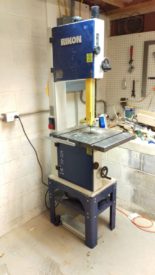

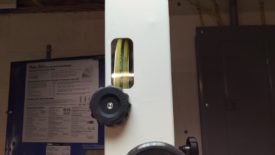
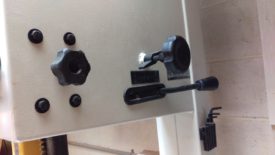
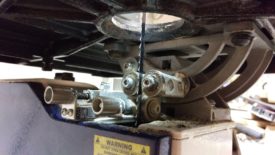
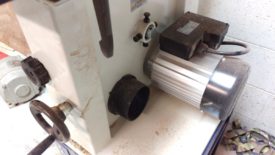
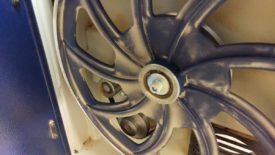


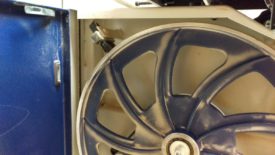

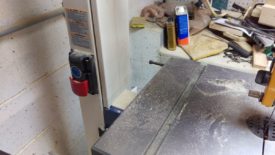
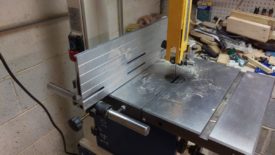
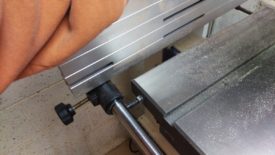
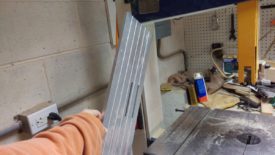
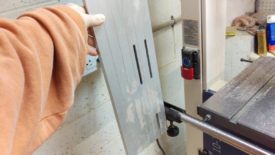
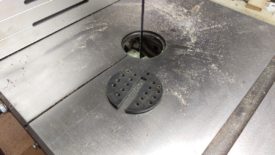
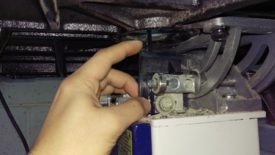
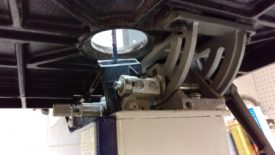

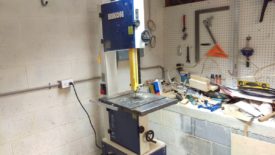
Hi, thanks for the review. I’m considering the same saw, and you definitely helped me with some questions I had.
Regarding the pin in the side of the table–it keeps the two table halves coplanar on either side of the blade slot. Without it, there could conceivably be flex between one side and the other. It’s somewhat hypothetical since the table is fairly sturdy, but that is the theory anyway.
Thanks for the feedback, glad I could help. Regarding the pin, that makes a lot of sense. I’m not sure it’s a tight enough fit to really do that well, and you’re right – the table is thick enough that I seriously doubt it would flex independently of the other half. Still, good to know!
Now that you’ve had the 10-324 for 8 months, do you still like it, any regrets?
It has worked out really well so far, once I got that cheap zero clearance insert. The fence is still a little mediocre and I’d like to make a new base still, but the saw cuts well, has plenty of power, runs on 110, and tracks/tensions easily, so I’m happy.
Thanks James, think I’m going to get the 324 but will upgrade to the tool less guides, and a aftermarket fence. woodcraft has the 324 on for $649
I think you’ll enjoy it. At that price point, it’s the same capacity as a Grizzly with a riser block, but a better saw, in my opinion, for actually a bit less money.
I’m working on my first bandsaw project, with my new Rikon 10-324. I’ve never used a bandsaw before, and don’t even have anybody at hand to tell me if things are right or going off the rails. I’m struggling through though, and enjoying most of it.
Here’s my issue: I’m resawing a board 4 1/2″ wide and 14″ long into 3/8″ thins, then planing them to 1/4″. When I start the resaw cut, it swoops to the left toward the fence, like some really drastic drift, but then straightens out! I can see the blade flex to the left. During the cut, it will again drift to the left, but it’s so un-uniform that I can’t just set the fence to compensate. It was fine yesterday, but today — not so much. Overnight I removed the blade to clean the gunk off, and re-installed it this morning. I’ve monkeyed with the tension and tracking, but I think my problem is the blade guides. I can’t seem to get them set right, and can’t even figure out how to set the lower ones. I have the originals, and am going tomorrow to buy the upgrade kit, but they’re still round bearings and not blocks, so I’m thinking I may still have the same issue. When I think I have the guides set right, I can hear/feel the blade slip off of the top back guide while I’m cutting. That just can’t be right! I have to push the wood pretty hard to get it to go at all. Maybe my blade is already dull? I literally made my first cut last week, but the wood I’m working with is hard, splintery, gummy stuff. Lacewood. Beautiful, but not the easiest to handle or cut.
I realize this is a 10-324 review, and this may be a generic problem. I posted here because of my difficulties & frustration with the guides. Any feedback, including pointers to more appropriate forums would be appreciated. thanks!
Now I have black grease coming from the upper thrust bearing, and can’t come close to cutting a straight line. Feeling defeated, but maybe things will look brighter tomorrow.
Replaced the stock blade guides with the new upgrade from Rikon. Cranked the tension way up and backed off a bit on the top thrust bearing. The blade still tracks way to the right on the bearing, but I’m getting good cuts now. 🙂
My apologies, I was travelling and am only just now seeing these comments.
Which upgrade kit are you referring to, the tool-less guides? One of the perks of the Rikon is that it already comes with bearing guides, which are generally preferable to cool blocks and similar. I think the toolless guides are primarily for convenience.
The stock tension gauge probably does underrate things (see here: https://woodgears.ca/bandsaw/tension.html )
However, you probably just need to adjust the side guides closer together. The blade is going to ride one one of the left or right bearings, so if they’re spaced too far apart, it will track further left/right than you want. Matthias (Woodgears) also has a good guide on this adjustment as well, and I can’t find it for the life of me. Long story short, i like to have a very small gap between the glade and the guides, so they don’t touch when the saw is run before cutting, but they’re close enough to hold it. We’re talking like close enough that you barely fit a piece of paper between the blade and the guide.
I hope the new saw works out for you!
That’s helpful! I didn’t know one of the guides was supposed to actually touch the blade when it’s cutting. I have them set too far apart. I’ll fix that. Cranking up the tension helped by miles, too. Yes, the guide upgrade was the tool-less guides from Rikon. I really like them — easy to adjust. Only downside is the new knobs are big and make it hard to see where the bearings are in relation to the gullets. But the ease of setting them is outstanding. Glad I made the investment.
I called Rikon, and they helped me figure out how to fix it so the blade runs in the center of the thrust bearing. Just unscrew the four bolts in the back a little and shove the whole blade guard assembly a little to the right. It’s perfectly centered now. Rikon support was awesome.
Thanks for getting back to me. I’ve never actually used a band saw before this, and I don’t know anyone who has one. Flying blind, but learning is fun!
Excellent. Fortunately, I haven’t needed their support or service yet, but I’ve heard it’s absurdly good, another perk to this saw.
Yep, itll push over and touch the guide, that’s what they’re there for! It will push back and touch the thrust bearing, as well. As long as the cut is good and you have enough of a gap so the blade isn’t rubbing on the guides when the saw is on but you aren’t cutting, you should be all set. (Just a hairs breadth away, for the most part – there are a ton of youtube videos on bandsaw setup, as well, just goes a bit outside the scope of a disqus comment!)
Just saw your review and it is quite good. Having looked at the Rikon video for the 10-326 https://www.youtube.com/watch?v=_bwNm4JdfeY It appears they may have improved a few things like the fence. Having bought a couple of grizzley tools years ago, one of which was a band saw capable of mounting a 1″ blade, both the switch broke and later one of the cast wheels broke. To say I will never again buy a grizzley tool is a given no matter that they may have improved. I see the Rikon 10-326 can be bought for 899 and looks like the 324 may only be a 100.00 less. Any impressions on this?
Like I said in the above review, the fence and stand on the 326 definitely look like significant upgrades. The fence actuation looks much more pleasant, and the closed stand would be a lot more useful for storage. You also get another 1/4 horsepower on the motor.
That said, I don’t think it’s really only a $100 difference. I bought the 324 on sale for $699, and a commenter below was able to purchase it for $649. That said, maybe $200-$250 is worth a closed stand, better fence, and a bit more power to you. I’m sure the 326 is a good saw.
I’ve got the 10-326 and I am here to tell you that the enclosed stand is a tank. It is solid steel. The 326 is by far the better saw and worth every penny. The tooless blade guide system is the best I’ve ever used. Adjusting your bandsaw blade can be a pain in the butt so it is nice not having to use tools to adjust the guides. Once you graduate to a novice bandsaw user making adjustments becomes much easier. As far as the blade wandering on you or pulling in one direction i would first look at how tight your tension is set to. All you have to do is quickly tap the blade with your finger on the side, not the sharp part and you should get a higher pitched sound, not a dull flat sound. Once the tension is set make sure you are tracking on the middle of the top wheel. I’ve heard people saw make sure the teeth of the blade are centered on the wheel but find your spot and check it out. Now set your guides. As close as you can get them with out touching the blade. Make sure the thrust bearing is set so as to prevent the side bearing from touching the actual teeth of the blade when you push your wood into the blade. My only 2 cons with the 10-326 is that the 110v outlet on the saw used for a dust collector or light is only powered on when the saw is actually switched on. This isn’t a big deal for a dust collector but a constant power outlet for a light would be amazing. The other con is, well it’s actually just a feature i wish it had is a foot brake to stop the blade quicker. It can continue to spin for quite a long time after turning the saw off.
I would buy the 10-326 again in a heart beat. Once you get yours I recommend your first project be a bandsaw box. Super easy to make and good practice. Enjoy.